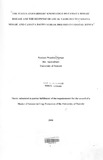| dc.description.abstract | Mitigation of cassava mosaic disease (CMD) focuses on the introgression of resistance imparted by the polygenic recessive (CMD1), dominant monogenic (CMD2) and CMD3 loci. The mechanism(s) of resistance they impart, however, remain unknown. Two CMD susceptible and nine CMD resistant cassava genotypes were inoculated by microparticle bombardment with infectious clones of African cassava mosaic virus Cameroon strain (ACMV-CM) and the Kenyan strain K201 of East African cassava mosaic virus (EACMV KE2 [K201]). Genotypes carrying the CMD1 (TMS 30572), CMD2 (TME 3, TME 204 and Oko-iyawo) and CMD3 (TMS 97/0505) resistance mechanisms showed high levels of resistance to ACMV-CM, with viral DNA undetectable by PCR beyond 7 days post inoculation (dpi). In contrast, all genotypes initially developed severe CMD symptoms and accumulated high virus titers after inoculation with EACMV KE2 (K201). Resistant genotypes recovered to become asymptomatic by 65 dpi with no detectable virus in newly formed leaves. Genotype TMS 97/2205 showed highest resistance to EACMV KE2 (K201) with <30% of inoculated plants developing symptoms followed by complete recovery by 35 dpi. Deep sequencing of small RNAs confirmed production of 21–24 nt virus derived small RNAs (vsRNA) that mapped to cover the entire ACMV-CM and EACMV KE2 (K201) viral genomes in both polarities, with hotspots seen within gene coding regions. In resistant genotypes, total vsRNAs were most abundant at 20 and 35 dpi but reduced significantly upon recovery from CMD. In contrast, CMD susceptible genotypes displayed abundant vsRNAs throughout the experimental period. The percentage of vsRNAs reads ranked by class size were 21nt (45%), 22 nt (28%) and 24 nt (18%) in all genotypes studied. The number of vsRNA reads directly correlated with virus titer and CMD symptoms. | en_US |



